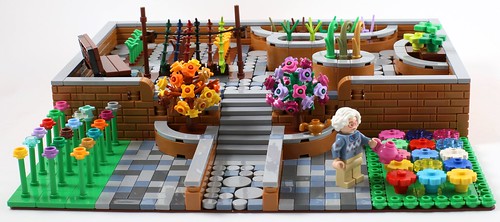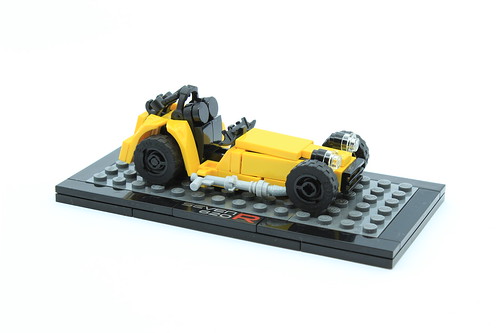As long as there have been stories, there have been different ways to tell them. It started with pictograms on rock walls, oral traditions, cuneiform on clay tablets and heiroglyphics on papyrus. Along came written alphabets, movable-type, postal services, telegraphs, telephones, radio, cinema, television, and mobile internet. But the medium for storytelling has never just been a technological choice, but also an artistic one. Stories have long been expressed in paint, sculpture, dance, and music, both instrumental and vocal.
Storytelling is an expression of a human need, and humans have always told stories using whatever tools, technologies, materials, and abilities were available to them. So why not plastic? Acrylonitrile Butadiene Styrene (ABS), to be specific. ABS is of course the material of choice for the interlocking elements created by The LEGO Group. Sure, there are a few minor exceptions. Transparent parts are polycarbonate, a lot of tree an plant parts are made from polyethlyene (now sustainably sourced), and there are even a few rubber parts out there like tire treads and pointy bits that won't poke your eye out. But for the most part, LEGO means ABS. It's stong and shiny, it can be molded in huge gamut of colors, and it's durable enough to last generations and connect as well as ever.
Lego's ever-increasing range of shapes and colors for its ABS elements gives users the ability to connect and arrange those parts in new ways and make more detailed and accurate models, which can be reproductions of iconic objects in the real world, or physical manifestation of the figments of imagination. Often, the plastic is all you need, and a model can speak for itself or be left open to interpretation. But other times, you need words.
I like words, particularly written ones. I enjoy reading well-crafted prose. And I enjoy crafting phrases, sentences, and paragraphs. That's probably why it took me three paragraphs to get to the point of this post. When you build LEGO, adding words allows you to shape the story that people see in your creations. Words can develop a backstory in great detail or hint a vague outline. Words can pull the viewer into the middle of the story, and a question can plant the story into their mind. Words can blatantly point to what will happen next, or provide just enough hint for the viewer's imagination to write the next scene, act, or chapter.
The internet is a wonderful medium to attach written words to LEGO creations. A LEGO convention or smaller public display is an opportunity to enhance a creation with spoken words as you interact with your audience. But as I discovered at my first convention a few years ago, conventions can also offer a unique way to add written words to a LEGO creation. At BrickFair, this is called the MOC card. It's a physical piece of cardboard or paper, the same size as a business card, with a standard format and some basic information. It has the builder's name and if they choose to share, their age and where they live. And it gives you space for a title and a brief written description. The same description ends up on the convention web page where other exhibitors can browse through summaries and photos and vote for their favorites. It's not much space, but it's enough.
The first MOC I brought to BrickFair was a wrecked submarine on the bottom of the ocean, covering a single standard 32 x 32 stud baseplate. Specifically, it was the Soviet submarine K-129. It was also the first step in a multiyear plan to tell a bigger story about the submarine, and the CIA's partially-successful attempt to recover it. On the MOC card, I wanted to hint at the larger story but I didn't want to give it all away, and certainly didn't have room to do so anyway. So I whittled and honed the story down to it's bare essentials, printed it out, and set it on the table.
Some people walked by, some people slowed and skimmed my card, and some read every word. Some asked questions, and some had their own stories to tell. The convention was in Chantilly, Virginia, not terribly far from the actual home of the Central Intelligence Agency. Maybe I shouldn't be too surprised to have met two different attendees with a personal connection to the historic events I depicted. Nonetheless, it was an amazing and unexpected experience.
At the same convention, my wife built a small vignette of a control room for a nuclear power plant in the world of the Lego Friends theme. We called it Heartlake Energy, after the colorful city the theme is based around. It needed a description placed the vignette in its setting, highlighted the important technical duties of the characters, and reflected the overall positivity of all things Friends through a subject that not everyone has positive feelings about. On the MOC card, I gave this description:
"The women of Heartlake Nuclear Generation Station monitor the control room to keep the reactor operating smoothly, so the city is always bright and full of energy."
The following year, we expanded to include a lobby, reception area, and larger colorful reactor room. I hope to build the rest of the plant eventually, including a large cooling tower.
Last year, I had fun describing the lunar arboretum and solar farm I built as part of a larger collaborative moon colony display. This year, I have an even bigger display with an even bigger story. Even without MOC cards, I'm pretty confident people would be able to figure out what I'm showing and some of the story I want to tell. But I can't imagine missing the chance to add color and depth to the scene with a few short phrases. And just as soon as I finish building, I'll share that story too, one card at a time.
Storytelling is an expression of a human need, and humans have always told stories using whatever tools, technologies, materials, and abilities were available to them. So why not plastic? Acrylonitrile Butadiene Styrene (ABS), to be specific. ABS is of course the material of choice for the interlocking elements created by The LEGO Group. Sure, there are a few minor exceptions. Transparent parts are polycarbonate, a lot of tree an plant parts are made from polyethlyene (now sustainably sourced), and there are even a few rubber parts out there like tire treads and pointy bits that won't poke your eye out. But for the most part, LEGO means ABS. It's stong and shiny, it can be molded in huge gamut of colors, and it's durable enough to last generations and connect as well as ever.
Lego's ever-increasing range of shapes and colors for its ABS elements gives users the ability to connect and arrange those parts in new ways and make more detailed and accurate models, which can be reproductions of iconic objects in the real world, or physical manifestation of the figments of imagination. Often, the plastic is all you need, and a model can speak for itself or be left open to interpretation. But other times, you need words.
I like words, particularly written ones. I enjoy reading well-crafted prose. And I enjoy crafting phrases, sentences, and paragraphs. That's probably why it took me three paragraphs to get to the point of this post. When you build LEGO, adding words allows you to shape the story that people see in your creations. Words can develop a backstory in great detail or hint a vague outline. Words can pull the viewer into the middle of the story, and a question can plant the story into their mind. Words can blatantly point to what will happen next, or provide just enough hint for the viewer's imagination to write the next scene, act, or chapter.
The internet is a wonderful medium to attach written words to LEGO creations. A LEGO convention or smaller public display is an opportunity to enhance a creation with spoken words as you interact with your audience. But as I discovered at my first convention a few years ago, conventions can also offer a unique way to add written words to a LEGO creation. At BrickFair, this is called the MOC card. It's a physical piece of cardboard or paper, the same size as a business card, with a standard format and some basic information. It has the builder's name and if they choose to share, their age and where they live. And it gives you space for a title and a brief written description. The same description ends up on the convention web page where other exhibitors can browse through summaries and photos and vote for their favorites. It's not much space, but it's enough.
The first MOC I brought to BrickFair was a wrecked submarine on the bottom of the ocean, covering a single standard 32 x 32 stud baseplate. Specifically, it was the Soviet submarine K-129. It was also the first step in a multiyear plan to tell a bigger story about the submarine, and the CIA's partially-successful attempt to recover it. On the MOC card, I wanted to hint at the larger story but I didn't want to give it all away, and certainly didn't have room to do so anyway. So I whittled and honed the story down to it's bare essentials, printed it out, and set it on the table.
Some people walked by, some people slowed and skimmed my card, and some read every word. Some asked questions, and some had their own stories to tell. The convention was in Chantilly, Virginia, not terribly far from the actual home of the Central Intelligence Agency. Maybe I shouldn't be too surprised to have met two different attendees with a personal connection to the historic events I depicted. Nonetheless, it was an amazing and unexpected experience.
At the same convention, my wife built a small vignette of a control room for a nuclear power plant in the world of the Lego Friends theme. We called it Heartlake Energy, after the colorful city the theme is based around. It needed a description placed the vignette in its setting, highlighted the important technical duties of the characters, and reflected the overall positivity of all things Friends through a subject that not everyone has positive feelings about. On the MOC card, I gave this description:
"The women of Heartlake Nuclear Generation Station monitor the control room to keep the reactor operating smoothly, so the city is always bright and full of energy."
The following year, we expanded to include a lobby, reception area, and larger colorful reactor room. I hope to build the rest of the plant eventually, including a large cooling tower.
Last year, I had fun describing the lunar arboretum and solar farm I built as part of a larger collaborative moon colony display. This year, I have an even bigger display with an even bigger story. Even without MOC cards, I'm pretty confident people would be able to figure out what I'm showing and some of the story I want to tell. But I can't imagine missing the chance to add color and depth to the scene with a few short phrases. And just as soon as I finish building, I'll share that story too, one card at a time.










